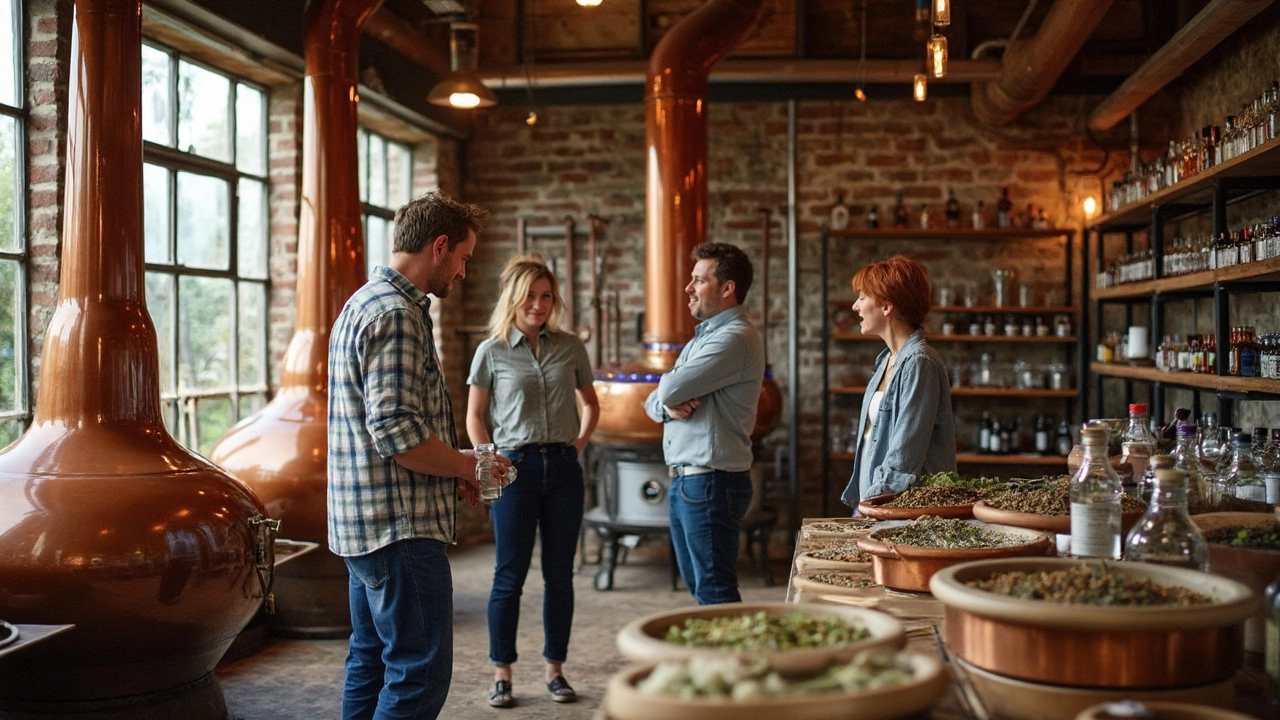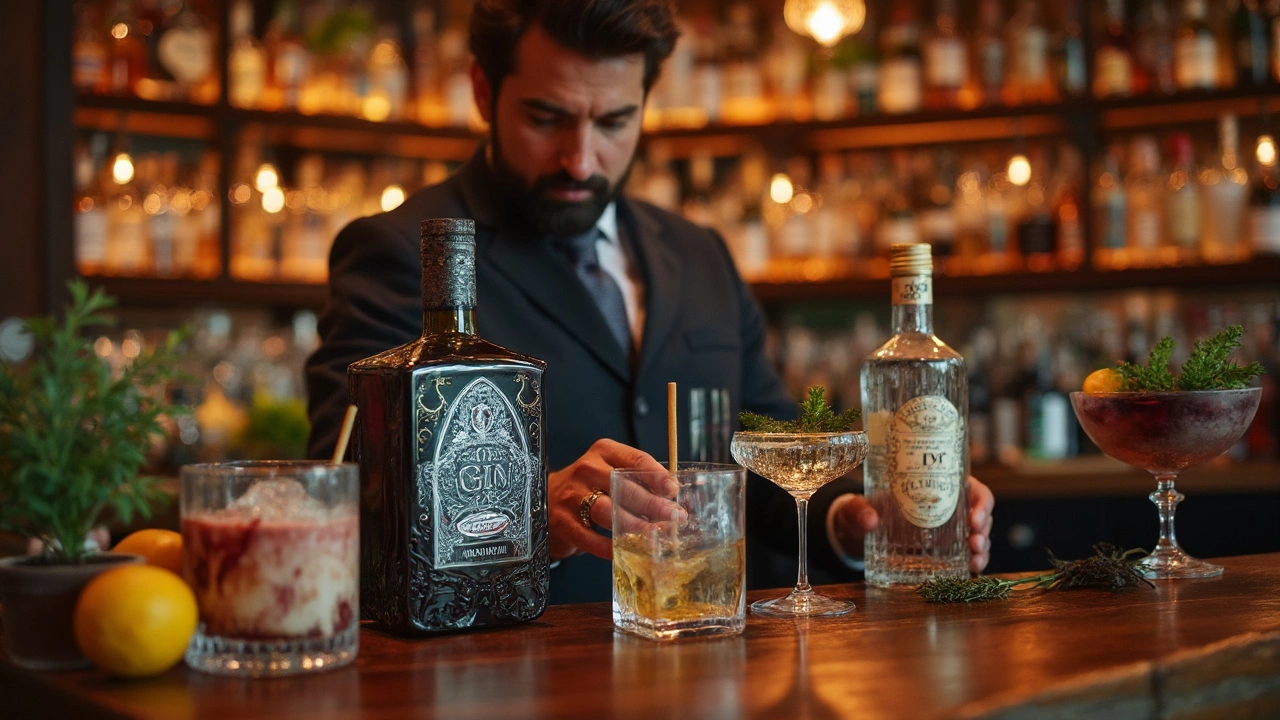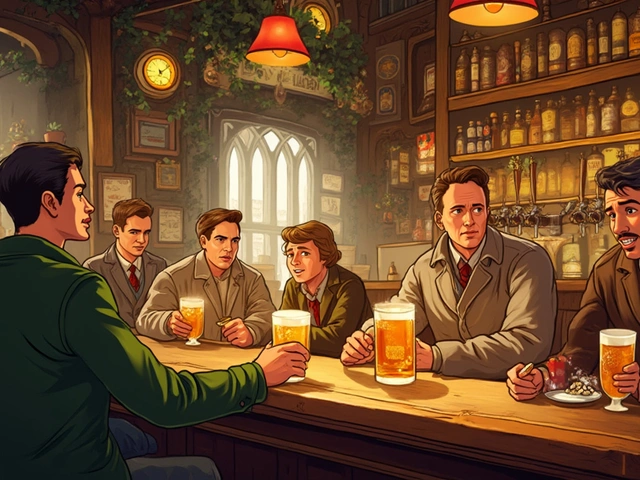The phrase “top shelf gin” gets thrown around a lot, but what does it actually mean? You’ll see bottles sporting wild price tags at bars, but that doesn’t always make them special. When people talk about top shelf gin, they’re looking for more than hype—real quality, unique flavors, and usually a story behind the bottle.
If you’re wondering what separates the top shelf stuff from the ordinary, it’s not just fancy packaging. True premium gin stands out because of what goes in (and just as important, what gets left out). It’s all about the choice of botanicals, the distilling process, and the skill of the people making it. Some distilleries will go to insane lengths—think hand-peeling citrus or using rare herbs grown in their own gardens—to get flavors you won’t find on the bottom shelf.
Tasting a well-made gin is a whole different experience. You can actually pick out the different flavors, like floral notes from orris root or spicy hints from cubeb berries, not just a blast of alcohol. And if you ever get the chance to walk through a small-batch distillery, you’ll quickly see why the best stuff costs a bit more—it’s practically a craft project, not just a bottle rolling off an assembly line.
- What Does 'Top Shelf' Even Mean?
- Taste and Botanicals: The Heart of Premium Gin
- Famous Top Shelf Gins (And Why They Stand Out)
- Craft vs Mass-Produced: Who’s Making the Best?
- What You Actually Get on a Gin Distillery Tour
- How to Pick Your Own Top Shelf Favorite
What Does 'Top Shelf' Even Mean?
You’ll hear bartenders and gin geeks toss around the phrase “top shelf” like it’s a badge of honor, but what puts a gin up there? The most basic answer: these are the bottles everyone wants to show off—usually sitting on the highest shelf at a bar, out of easy reach. That said, ‘top shelf’ stands for a lot more than just being expensive or well-known.
Top shelf gins are picked for quality, not price alone. They use better ingredients, often source rare botanicals, and get crafted with real attention to detail. We’re talking copper pot distillation, small batches, unique flavors, and strict standards. These brands care about the final taste way more than churning out loads of product fast.
Here are some real signs you’re looking at top shelf gin:
- Clear, unique flavor—no burn, no chemical aftertaste.
- Transparency about what’s inside (botanicals, water source, process).
- Often made in small batches, sometimes using ancient or special methods.
- Thoughtful design—if a distiller cares about every detail, it usually shows in the packaging too.
When you compare “top shelf” gins with regular ones, the differences can be pretty clear. Here’s a quick breakdown:
| Feature | Top Shelf Gin | Standard Gin |
|---|---|---|
| Botanicals | Rare, high quality, often local | Standard, mass-sourced |
| Distillation | Small batch, traditional copper pot | Large-scale, industrial stills |
| Transparency | Detailed info on process/ingredients | Minimal info given |
| Price Range | $35–$70+ per 750ml | $12–$30 per 750ml |
Here’s the twist though: top shelf gin isn’t just about spending more. Some people swear by a small rebottler or local brand over the usual big-name imports. The best way to spot the real deal? Try different bottles, pay attention to flavor, ask questions, and see for yourself who’s really making something special—not just selling a fancy label.
Taste and Botanicals: The Heart of Premium Gin
The first thing people notice about top shelf gin is the flavor. Good gin isn’t about overwhelming alcohol or just tasting like a Christmas tree. Top producers use a gin recipe that balances a group of core botanicals, but they add their own twist with special extras. Every gin starts with juniper berries—that's the one thing required. After that, the magic happens with whatever else they add. Some brands lean hard on citrus peel for freshness, while others go earthy with roots and spices.
If you’ve had a classic London Dry gin, you probably tasted a crisp, piney hit from juniper and maybe some orange or lemon peel. Premium gins take it way further. Think of a bottle like Monkey 47 from Germany, packed with, you guessed it, forty-seven different botanicals. Or try a Japanese gin like Roku, which adds cherry blossom and yuzu peel for a floral kick you don’t find elsewhere.
The process matters just as much as the recipe. Top gins use real, natural botanicals—never chemical flavors or shortcuts. Some distillers use fresh-picked ingredients; others let their botanicals soak for days to get those flavors just right. The exact way they heat up the still and time the distillation has a massive impact too. That’s why the same gin recipe tastes completely different from one distillery to the next.
Want to spot a premium gin while shopping? Check the label for details. Look for clear info on which botanicals are actually used and if there’s anything unique, like hand-harvested herbs or locally sourced fruits. If they’re proud enough to list their ingredients, it’s usually a good sign. When you finally taste it, you’ll know—the layers of flavor are smooth, balanced, and don’t burn going down. That’s what separates the good stuff from the rest.
Famous Top Shelf Gins (And Why They Stand Out)
When folks talk about top shelf gin, they’re not just rattling off any old names. These bottles have credibility and real reasons why people seek them out. Some gins have won international awards, earned praise from bartenders, or just taste so good that fans can’t help but tell their friends.
Here are a few standout names and what makes them special:
- Hendrick’s Gin (Scotland): Known for its bold use of cucumbers and rose petals, Hendrick’s shook up the gin scene when it launched back in 1999. It’s light, floral, but still has enough punch for classic cocktails. Try it in a G&T with a cucumber garnish—you’ll taste why it’s popular worldwide.
- Bombay Sapphire (England): The blue bottle is pretty much iconic, but what’s inside is even better. Their vapor infusion method preserves delicate botanicals like lemon peel and almond, making it super smooth and easy to sip.
- Tanqueray No. Ten (England): If you want something citrusy, this is a good choice. Tanqueray No. Ten uses fresh grapefruit, orange, and lime along with traditional botanicals. It’s been called the “bartender’s choice” for martinis, and it’s easy to see why once you’ve tasted it.
- Sipsmith London Dry Gin (England): This was the gin that kicked off the craft movement in London. The team sticks to small batches and copper pot stills, so each bottle gets a lot of attention. Expect big, classic juniper flavors with a clean finish.
- The Botanist (Scotland): Made on the wild island of Islay, The Botanist uses 22 hand-foraged local botanicals. Each bottle lists them on the label, which is a neat touch. The taste is herbal, floral, and layered—perfect for folks who like to explore new flavors.
Here’s a quick comparison of these popular picks to help you sort what’s what:
| Gin | Origin | Main Botanicals | Best Use | Awards Won |
|---|---|---|---|---|
| Hendrick’s | Scotland | Cucumber, rose | Gin & Tonic | Gold, International Spirits Challenge |
| Bombay Sapphire | England | Lemon peel, almond | Neat or Cocktails | Silver, San Francisco World Spirits Comp. |
| Tanqueray No. Ten | England | Citrus, juniper | Martini | Double Gold, SFWSC |
| Sipsmith | England | Juniper, coriander | Classic cocktails | Gold, International Wine & Spirit Comp. |
| The Botanist | Scotland | 22 island botanicals | Garnished drinks | Gold, IWSC |
When picking a top shelf gin, watch for small batch or uniquely distilled options. These usually mean more care went into how it’s made. And don’t be afraid to ask at a distillery—most folks working there love talking details about their best bottles.

Craft vs Mass-Produced: Who’s Making the Best?
There’s a huge difference between craft gin and the big-name mass-produced bottles lining the supermarket. And it’s not just about price or pretty labels. It comes down to how the gin is made, what’s going in it, and how much control the distiller actually has over the end result.
Craft distilleries are usually small operations. They focus on quality, not quantity. You’ll find limited runs, experimental recipes, and sometimes even hand-filled bottles. A lot of these spots, like Sipsmith in London or St. George Spirits in California, started out because someone was obsessed with making gin better than the usual brands. They often use local or fresh botanicals, which gives their spirits some seriously unique flavors. People on distillery tours talk about actually watching the makers taste test their gin, tweaking recipes every batch, and even naming the stills. It’s up-close and personal.
Mass-produced gins, like Gordon’s or Beefeater, are made for consistency. They’ve got giant production lines and crank out thousands—sometimes millions—of bottles a year. The flavor will be the same whether you’re drinking it in London, Tokyo, or New York, and honestly, they’re reliable for mixing into cocktails. But don’t expect anything wild or new from these guys. You won’t get anything like those weird, peppery or citrusy notes you’ll find with a craft bottle.
If you’re still skeptical, check out these quick numbers:
| Gin Brand | Craft/Big | Annual Production | Unique Botanicals Used |
|---|---|---|---|
| Sipsmith | Craft | 700,000 bottles | 10+ |
| St. George Spirits (Terroir Gin) | Craft | ~100,000 bottles | 12+ (Douglas fir, bay laurel) |
| Gordon’s | Mass-Produced | Over 72 million bottles | 6 |
| Beefeater | Mass-Produced | Over 30 million bottles | 9 |
Don’t get me wrong: the classic mass-produced gins made top shelf gin famous in the first place. But if you want something with a distinct taste or a one-of-a-kind story, craft gin usually delivers more. Plus, lots of craft gins stick to sustainable sourcing and often put their whole process on display during tours. With the smaller guys, you just get more transparency—and something new in your glass with almost every batch.
What You Actually Get on a Gin Distillery Tour
So, what’s it really like to go on a gin distillery tour? Forget about walking through a quiet factory while someone drones on about production. A good tour is hands-on, up-close, and you get to see why your favorite gin tastes so different from the rest. Distilleries love showing off the weird and wonderful botanicals they use—sometimes stuff you've never even heard of, like angelica root or grains of paradise.
Your guide will walk you right up to the stills, those huge shiny machines where gin magic happens. You’ll probably get to smell different stages of production, from raw spirit to the finished product. Tours often explain the step-by-step difference between basic industrial gin and those small-batch bottles you see on the top shelf gin racks.
One cool part most folks don’t expect: you’ll usually get to taste the core botanicals on their own. Ever chewed on a dried juniper berry or nibbled fresh coriander? You might even get to touch, sniff, or crush ingredients to see (and smell) where the flavor comes from. Tour guides usually mix in just the right amount of geeky info—think “this is how we balance citrus and spice”—without making it overwhelming.
- Live tastings: You get shots of gin at different points in the process, from unfinished spirit to the final sip.
- How it’s made: Real explanations of distilling, not just buzzwords. It clicks when you see the tools, the copper stills, and the botanicals up close.
- Behind-the-scenes access: You might meet the head distiller, see secret recipes, or check out local ingredients you won't find in the grocery store.
- Shopping perks: Most distilleries offer exclusive bottles or special editions you can’t grab anywhere else. Sometimes they'll even let you fill your own bottle straight from the cask.
If you’re really lucky, you might swing by the tasting room at the end, where you can compare their different styles and experiment with mixers. Just ask questions—these folks love it when you’re curious, and you’ll walk away with stories, not just a souvenir bottle.
How to Pick Your Own Top Shelf Favorite
Standing in front of shelves stacked with gin can get overwhelming—bottles range from old-school classics to modern craft experiments, all claiming to be the best. So how do you actually zero in on your own top shelf pick?
Start with a quick flavor check. Pay attention to what you like. Some people swear by gins loaded with juniper and pine, while others want a fresh kick from citrus or a hit of floral notes. Don't just guess—grab a tasting flight at a local bar or sign up for a distillery tour where you can try samples side by side.
- Top shelf gin isn’t always about the most expensive option. Brands like Monkey 47 (Germany), Sipsmith VJOP (UK), and The Botanist (Scotland) are rated high for flavor complexity and careful distilling, not just price.
- Check the botanicals list on the label. Some producers are crystal clear about what goes in the still—like Bombay Sapphire’s ten listed botanicals or Hendrick’s twin stars of cucumber and rose. If you’re sensitive to certain spices, double-check before you buy.
- Look for info about the distillery process. Gins that mention small-batch, copper pot stills, or wild foraged ingredients usually deliver more punch in the flavor department. Quick industrial runs? Maybe not so much.
- Don’t skip the regional stuff. Local craft distilleries often use botanicals that are totally unique to where they’re located. If you’re on a gin distillery tour, pay attention to these. You might just find a hidden gem you won’t see in big box stores.
If you want to try a new bottle at home, mix up a simple gin and tonic—no fancy garnishes needed. This drink brings out the real flavors fast. Keep notes on what stands out in each gin. Was it peppery? Sweet? Herbal? Over time, you’ll notice what you like—and what isn’t worth it. That’s how you figure out your own real top shelf picks, no hype needed.


